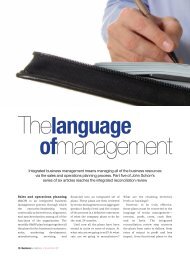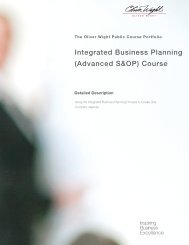Portfolio Management Article, written by Donald McNaughton of ...
Portfolio Management Article, written by Donald McNaughton of ...
Portfolio Management Article, written by Donald McNaughton of ...
You also want an ePaper? Increase the reach of your titles
YUMPU automatically turns print PDFs into web optimized ePapers that Google loves.
<strong>Portfolio</strong>management<br />
Part two <strong>of</strong> our series on product management focuses on the role<br />
<strong>of</strong> portfolio management in managing existing products as well as<br />
selecting and managing products for the product portfolio<br />
12 www.bus-ex.com March 08
Strategicmanagement<br />
The first article <strong>of</strong> this series<br />
defined product management as the<br />
role within a business that has the<br />
responsibility for managing the product<br />
portfolio. It also outlined the three core<br />
processes <strong>of</strong> portfolio management,<br />
project management, and resource<br />
management (figure 1), as well as the<br />
<strong>of</strong> these two issues <strong>of</strong>ten leads to a<br />
weak product portfolio that ultimately<br />
delivers lower pr<strong>of</strong>it margins.<br />
<strong>Portfolio</strong> management and its enabling<br />
process steps and roles mitigate or<br />
eliminate these conditions (Table 1).<br />
<strong>Portfolio</strong> <strong>Management</strong>, as defined, is a<br />
systematic process that manages the<br />
is an idea whose time has come’.<br />
Victor Hugo (1802-1885) French poet,<br />
dramatist and novelist. Product<br />
ideas are conceived and ultimately<br />
communicated through a variety <strong>of</strong><br />
means and channels, <strong>of</strong>ten unique to<br />
the industry or specific to a business.<br />
They can be conceived <strong>by</strong> consumers,<br />
thirteen enabling steps and roles <strong>of</strong> the<br />
process (figure 2).Many organizations<br />
do not have a systematic process in<br />
place to manage existing products<br />
through their lifecycles. There is also<br />
a lack <strong>of</strong> systematic processes for<br />
selecting and managing products to<br />
be phased in and phased out <strong>of</strong> the<br />
product portfolio. The combination<br />
products <strong>of</strong> a business through all the<br />
stages <strong>of</strong> the product lifecycle and is<br />
guided <strong>by</strong> the strategic intent and pr<strong>of</strong>it<br />
objectives <strong>of</strong> the business.<br />
<strong>Portfolio</strong> <strong>Management</strong> Enabling<br />
Process Steps and Roles:<br />
1. Idea screening<br />
‘There is one thing stronger than<br />
all the armies in the world, and that<br />
customers, suppliers, employees<br />
or <strong>by</strong> engaging an external product<br />
development service. Product ideas<br />
are generated through surveys, focus<br />
groups, individual contemplation,<br />
ideation sessions or research, and are<br />
communicated through documented<br />
reports and studies and physical or<br />
electronic idea submittal processes.<br />
March 08 www.bus-ex.com 13
No matter how the ideas are initially<br />
conceived and communicated, all<br />
must be first subjected to an initial<br />
screening step. The initial evaluation<br />
<strong>of</strong> the conceptual product ideas that<br />
are submitted to the business occurs<br />
during the formal Idea Screening<br />
Review. Here, they are evaluated and<br />
considered based on a series <strong>of</strong> “yes”<br />
or “no” criteria, such as:<br />
• Strategic fit: Does the idea<br />
align with the strategic intent <strong>of</strong> the<br />
business?<br />
• Market attractiveness: Are the<br />
market size, growth, and opportunities<br />
attractive?<br />
• Technical feasibility: Is there a<br />
reasonable likelihood that the product<br />
can be developed and produced?<br />
• Disqualifying variables: Are<br />
there any known legal, regulatory, or<br />
environmental issues?<br />
Financial criteria and hurdles are<br />
not part <strong>of</strong> the initial idea screening<br />
process. The ideas having potential<br />
merit are then distributed to the<br />
appropriate product managers for<br />
further evaluation.<br />
2. Product manager<br />
Product managers are responsible<br />
for refining the product ideas that<br />
pass the initial screening review and<br />
make their decisions on whether to<br />
further develop an idea based on<br />
the specific needs <strong>of</strong> the product<br />
portfolio. It is also critical that<br />
product managers manage each<br />
product through its entire product<br />
lifecycle. This includes existing<br />
products as well as new products to<br />
be phased in and mature products<br />
scheduled to be phased out <strong>of</strong> the<br />
product portfolio.<br />
For the ideas that address a need<br />
in the current product portfolio, the<br />
product manager works with the<br />
sponsor <strong>of</strong> the idea to complete a<br />
project proposal form. The objective<br />
is to expand on the criteria used in<br />
the idea screening review. Additional<br />
information is obtained and detailed<br />
for:<br />
• Strategic alignment<br />
• Project feasibility<br />
• Magnitude <strong>of</strong> the opportunity<br />
• Market attractiveness<br />
• Product advantage<br />
• Ability to leverage the businesses<br />
resources<br />
• Fit with business policies.<br />
High-level financial criteria and<br />
hurdles are now considered and<br />
included as part <strong>of</strong> the product<br />
managers’ screening process.<br />
3. Project proposal<br />
It is in the project proposal stage<br />
where the business case for each<br />
idea is developed and documented.<br />
The project proposal form is used for<br />
this purpose and typically involves<br />
a more detailed investigation <strong>of</strong> the<br />
product idea that results in a clear<br />
definition <strong>of</strong> the product, its value<br />
proposition, its target market, the<br />
voice <strong>of</strong> the customer, the competitive<br />
landscape, technical feasibility and<br />
the supporting financial plan.<br />
The content <strong>of</strong> the project proposal<br />
form will vary depending on the type <strong>of</strong><br />
project being proposed—a completely<br />
new product, line extension, packaging<br />
change, change in manufacturing<br />
source, divestiture, or product kill.<br />
Completing the project proposal<br />
form for the idea requires<br />
significantly more effort than the<br />
initial idea screening and the<br />
product manager screening. Part<br />
<strong>of</strong> the reason is that the necessary<br />
inputs are required from multiple<br />
sources and at a greater level <strong>of</strong><br />
detail. We recommend that this task<br />
be assigned to a cross-functional<br />
group that will most likely form the<br />
nucleus <strong>of</strong> the project team if the<br />
project is approved.<br />
The project proposal form will be<br />
used as the basis for the next step<br />
in the process, the evaluation, which<br />
will be conducted <strong>by</strong> the <strong>Portfolio</strong><br />
<strong>Management</strong> Committee. This group <strong>of</strong><br />
senior executives decides whether the<br />
idea should progress to the next stage<br />
<strong>of</strong> development and, thus, become a<br />
formal project within the business.<br />
14 www.bus-ex.com March 08
Strategicmanagement<br />
4. Product coordinator<br />
The project proposal form, once<br />
completed, is submitted to the<br />
product coordinator, who reviews the<br />
project proposal form for accuracy<br />
and completeness. It is important<br />
to note that the product coordinator<br />
does not evaluate the merits <strong>of</strong> the<br />
idea being proposed, but he or she<br />
does have a vital role in an effective<br />
product management process and is<br />
responsible for:<br />
• Overall product management<br />
process<br />
• Coordination between the<br />
product managers and the <strong>Portfolio</strong><br />
<strong>Management</strong> Committee<br />
• Coordination between the<br />
project managers and the <strong>Portfolio</strong><br />
<strong>Management</strong> Committee<br />
• Coordination <strong>of</strong> the monthly<br />
project status update (input to Sales<br />
& Operations Planning process)<br />
• Coordination <strong>of</strong> the monthly<br />
Product <strong>Management</strong> Review (Step 1<br />
<strong>of</strong> the S&OP process).<br />
If all is in order with the project<br />
proposal form, the product coordinator<br />
schedules a gate review with the<br />
<strong>Portfolio</strong> <strong>Management</strong> Committee.<br />
5. <strong>Portfolio</strong> <strong>Management</strong><br />
Committee (PMC)<br />
The PMC is a cross-functional<br />
decision-making committee that<br />
assesses the merits <strong>of</strong> projects<br />
based on how well they support the<br />
strategic intent and pr<strong>of</strong>it objectives<br />
<strong>of</strong> the business. All project proposal<br />
forms are evaluated in the context<br />
<strong>of</strong> the entire product portfolio, and<br />
only the PMC has the authority to<br />
add or subtract a product from the<br />
product portfolio.<br />
Many businesses use scoring<br />
models where the PMC members<br />
score a proposed project using<br />
predetermined criteria. The source<br />
<strong>of</strong> their information is the project<br />
proposal form. Scoring the proposed<br />
project allows the PMC to compare<br />
the project to other proposed or<br />
approved projects and then to<br />
prioritize it based on attractiveness<br />
and available resources.<br />
Typically, most businesses have<br />
more opportunities than they have<br />
the resources to support, so once<br />
the proposed project has been<br />
scored and prioritized, a decision<br />
is made whether the project should<br />
go onto the next stage, be put on<br />
hold until resources are available<br />
to execute it, recycle to the<br />
previous stage to gather additional<br />
information required <strong>by</strong> the PMC,<br />
or be killed.<br />
If the project is given the green<br />
light to go to the next stage, a project<br />
team is formed which then executes<br />
the tasks associated with the next<br />
stage <strong>of</strong> the project. If the project is<br />
put on hold, no further work is done<br />
on the project until authorized <strong>by</strong><br />
the PMC.<br />
When the decision is made<br />
to recycle a project, the project<br />
sponsor and product manager<br />
gather the additional information<br />
required <strong>by</strong> the PMC and resubmit<br />
the project proposal form to the<br />
product coordinator. If the project<br />
is killed, then no further work is<br />
done on it.<br />
After the project team has<br />
completed the tasks associated<br />
with a specific stage <strong>of</strong> the project<br />
and before they can move onto<br />
the subsequent stage <strong>of</strong> work, the<br />
project team leader presents the<br />
results <strong>of</strong> the work before the PMC,<br />
commonly referred to as a Gate<br />
Review Meeting. This Gate Review<br />
process is repeated after each stage<br />
<strong>of</strong> work.<br />
The third article in this series<br />
will explain how the project<br />
management core process and<br />
its enabling process steps and<br />
roles support an effective product<br />
management process.<br />
<strong>Donald</strong> <strong>McNaughton</strong>, an Oliver Wight principal, is a consultant and educator providing guidance on the design and<br />
implementation <strong>of</strong> effective business processes, including sales and operations planning and product management.<br />
March 08 www.bus-ex.com 15
















